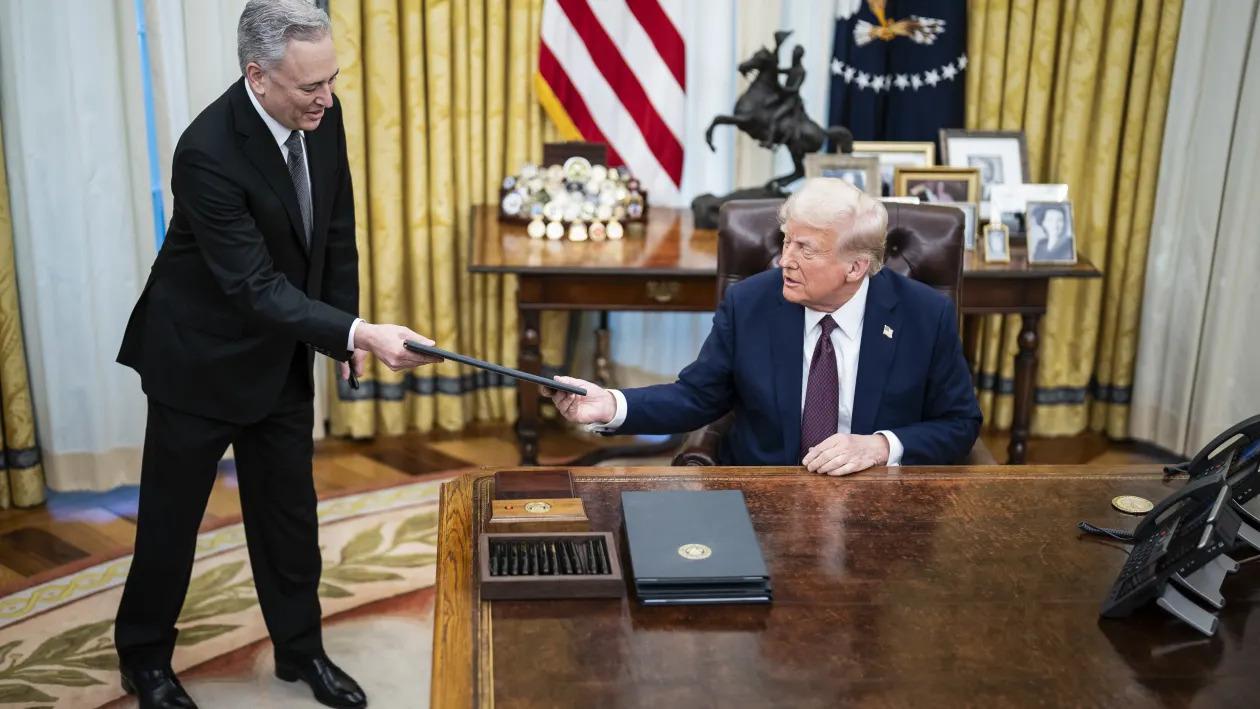
Author: Weilin, PANews
At 8:00 am on March 7th, Beijing time, David Sacks, director of artificial intelligence and encryption policy at the White House, announced on the X platform that US President Trump has officially signed an executive order to establish a strategic Bitcoin reserve and a digital asset reserve. However, since both reserves are mainly supported by "proceeds from criminal or civil asset forfeiture", the market reacted negatively in the short term, and the price of Bitcoin once fell below $85,000, down 4.21% in 24 hours, and then rebounded slightly.
It is reported that the presidential executive order is not a law and has certain limitations on its scope of effectiveness. Some analysts pointed out that there may still be positive news about the "Bitcoin Strategic Reserve" in the subsequent congressional legislation. At the same time, some industry insiders believe that the impact of Trump's market on the market will gradually weaken, and the encryption industry will enter a new stage, and attention should be returned to the application layer.
Bitcoin Strategic Reserve: Based on confiscated assets, an audit and budget neutral strategy will be implemented
“The reserve will be funded by bitcoin held by the federal government that was acquired through criminal or civil asset forfeiture proceedings, meaning there will be no cost to taxpayers,” David Sacks, the White House director of artificial intelligence and crypto policy, said in a statement.
He noted that the U.S. government is estimated to hold about 200,000 bitcoins, but has never been fully audited before. This executive order requires a comprehensive audit of the federal government's digital asset holdings. The U.S. will not sell the bitcoins deposited in the reserve, but will use them as a store of value. This reserve is like Fort Knox, the "digital gold" version of the cryptocurrency world. "
In addition, Sacks mentioned that premature sales of Bitcoin have caused U.S. taxpayers to lose more than $17 billion in value. Now, the federal government will develop strategies to maximize the value of its holdings. The Secretary of the Treasury and the Secretary of Commerce are authorized to develop budget-neutral strategies to acquire more Bitcoin, provided that these strategies do not impose additional costs on U.S. taxpayers.
The executive order also establishes the U.S. Digital Asset Reserve, which includes digital assets other than Bitcoin that have been confiscated in criminal or civil proceedings. The government will not acquire additional assets in the reserve, which will only come from forfeiture proceedings. The goal of the reserve is for the Treasury Department to responsibly manage the digital assets held by the government.
Sacks concluded his statement by thanking Trump for his efforts to promote the establishment of a strategic Bitcoin reserve and thanking his colleagues in the government: “President Trump promised to create a strategic Bitcoin reserve and a digital asset reserve, and now these promises have been fulfilled. This executive order highlights President Trump’s commitment to making the United States the ‘global crypto capital.’ I want to thank the President for his leadership and vision in supporting this cutting-edge technology, and his efficient execution in promoting the development of the digital asset industry.”
“I also want to thank the President’s Digital Asset Markets Task Force, especially Treasury Secretary Scott Bessent and Commerce Secretary Howard Lutnick, who provided critical support in making this happen. Finally, Bo Hines played a critical role as the Task Force’s Executive Director,” he said.
Establish two asset holding mechanisms, and promote legislation in Congress on Bitcoin strategic reserves
According to the division of the executive order, Trump’s executive order established two different digital asset holding mechanisms:
- 1. Strategic Reserve, which only stores Bitcoin (BTC). The initial funding source is about 200,000 Bitcoins obtained by the government through criminal and civil forfeiture over the years. It authorizes Treasury Secretary Bessent and Commerce Secretary Lutnick to explore ways to obtain more Bitcoin without increasing the burden on taxpayers. It is positioned as a national digital value reserve.
- 2. The Digital Asset Stockpile includes other digital assets besides Bitcoin, which may include XRP, ADA, ETH, SOL and other assets. The Ministry of Finance is responsible for the "responsible management" of the digital assets held by the government. The government will only explore the use of budget-neutral methods to purchase more Bitcoin, and will not actively seek to increase the number of other digital assets in the reserve. The executive order also requires a comprehensive audit of all digital assets currently held by the government to ensure transparency in asset management.
In fact, as early as March 3, Trump said that the US strategic crypto reserves will include XRP, Solana (SOL), Cardano (ADA), Bitcoin (BTC) and Ethereum (ETH), and these assets may appear in the digital asset reserves required by this executive order. However, some industry insiders have questioned the inclusion of XRP and ADA, believing that they lack the developer activity and decentralized characteristics of BTC and ETH.
In addition to Trump's executive order, the Bitcoin strategic reserve promoted by Senator Lummis is still in the process of being promoted in Congress. Alex Xu, research partner of Mint Ventures, wrote that this "Strategic Bitcoin Reserve" is not the same as the "Strategic Federal Reserve" bill promoted by Senator Cythia Lummis at the federal level. The former can be directly controlled by the government, while the latter needs to be legislated by Congress; the former itself does not have a separate budget for purchasing BTC (if it needs to be increased, it needs congressional approval), while the latter will provide a separate budget for purchasing BTC. The goal of the bill is to buy 1 million in 5 years. The source of the budget may come from the revaluation of the value of the existing US gold reserves, thereby expanding the asset count of the Federal Reserve and providing a budget for the Treasury to purchase BTC. What David Sacks said, "The government will not acquire other assets for reserve assets", does not mean that the Bitcoin strategic reserve in the public's impression has suddenly become something that only relies on confiscations and does not spend money to buy BTC separately.
Market reaction: Bitcoin price rebounds after a short-term drop, concerns about increased enforcement
Although the US government claimed that it would develop budget-neutral strategies to acquire Bitcoin, the statement also explained that the premise was that these strategies would not bring incremental costs to US taxpayers, which disappointed market expectations and put pressure on Bitcoin prices. Previously, the market had expected that the United States might actively purchase more Bitcoin to replenish its reserves. As of the morning of March 7, the price of Bitcoin once fell below $85,000, down 4.21% in 24 hours, and then rebounded slightly.
According to Arkham Intelligence data, the U.S. government currently holds about $18.28 billion in seized crypto assets, of which Bitcoin accounts for the vast majority, with 198,109 coins worth about $17.87 billion. In addition, the government also holds $122 million in USDT and $119 million in ETH, while XRP, SOL and ADA do not appear in the asset list.
Coinbase executive Conor Grogan wrote on the X platform: "The U.S. government holds 198,109 bitcoins. This executive order means that about $18 billion of selling pressure will be reduced."
However, Alex Thorn, head of research at Galaxy Digital, said in a post on X: "The current balance of Bitcoin available for the US government to use as a strategic reserve is at most 88,000 BTC, which is only 43% of the current government holdings. This is because 112,000 BTC of the approximately 198,000 BTC currently held by the US government will be returned to Bitfinex."
Some markets have a pessimistic interpretation of the policy. @realwuzhe, a KOL in technology and crypto, posted: "Trump has just ordered the establishment of a national reserve of Bitcoin. But it is just to manage the previously confiscated Bitcoins well and ensure that they do not crash the market. He also emphasized that taxpayers' money will not be used to purchase new Bitcoins. It is equivalent to creating a huge name, but there is no new buying. The thunder is huge, but the raindrops are very small, and Bitcoin plummets in response."
He expressed concerns about the US government's increased enforcement efforts. "The US has now built up a Bitcoin reserve, but is not prepared to use taxpayers' money to buy coins. Where will the new coins come from? They must continue to be obtained through law enforcement. Next, the US has a great motivation to take enforcement actions against overseas exchanges and large holders of coins."
Chen Mo, a KOL in the crypto industry, said: "The US strategic reserve has landed. Although it will not actively buy BTC, at least the formal purpose has been achieved. It is not ruled out that other countries will buy it. Judging from the price reaction, it is not as good as market expectations. It is expected that the impact of Trump's market on the market will gradually weaken. There will be fewer and fewer foreseeable events in the future. The crypto industry will enter a new stage and attention should be returned to the application layer. In the next 1-2 years, the relaxation of compliance and supervision can create more opportunities."
Meanwhile, Bitwise Chief Investment Officer Matt Hougan is more optimistic, analyzing the possible impacts of the executive order:
- Greatly reduce the possibility of the US government "banning" Bitcoin in the future;
- Significantly increases the likelihood that other countries will establish strategic Bitcoin reserves;
- Accelerate the process of other countries considering building strategic Bitcoin reserves, as this provides a short-term window for countries to preempt further purchases of Bitcoin by the United States;
- Making it harder for institutions to portray Bitcoin as a “risky” or “unsuitable” asset to hold — this includes everything from national account advisory platforms to quasi-governmental agencies such as the International Monetary Fund (IMF).
On the first day of the executive order, several crypto industry executives will attend the "Digital Asset Summit" hosted by Trump in Washington, DC in the early morning of March 8, Beijing time. Earlier, Mike Alfred, founder of digital asset investment platform Eaglebrook Advisors, posted on the X platform: "It is reported that the Trump administration is preparing to announce a zero capital gains tax policy for cryptocurrency sales at the cryptocurrency summit on Friday (that is, cryptocurrency sales will be exempt from capital gains tax)."














